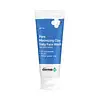What's inside
What's inside
 Key Ingredients
Key Ingredients

 Benefits
Benefits

 Concerns
Concerns

 Ingredients Side-by-side
Ingredients Side-by-side

Water
Skin ConditioningSodium Cocoyl Glycinate
CleansingMontmorillonite
AbsorbentSodium Cocoyl Isethionate
CleansingCocamidopropyl Betaine
CleansingDecyl Glucoside
CleansingAcrylates Crosspolymer-4
Emulsion StabilisingGluconolactone
Skin ConditioningNiacinamide
SmoothingLens Esculenta Fruit Extract
Skin ConditioningAlpha-Glucan Oligosaccharide
CleansingAloe Barbadensis Extract
Skin ConditioningGlycerin
HumectantPEG-50 Shea Butter
EmulsifyingTitanium Dioxide
Cosmetic ColorantSalicylic Acid
MaskingGlycolic Acid
BufferingAllantoin
Skin ConditioningPEG-120 Methyl Glucose Dioleate
EmulsifyingEthylhexylglycerin
Skin ConditioningPhenoxyethanol
PreservativeDisodium EDTA
Sodium Hydroxide
BufferingWater, Sodium Cocoyl Glycinate, Montmorillonite, Sodium Cocoyl Isethionate, Cocamidopropyl Betaine, Decyl Glucoside, Acrylates Crosspolymer-4, Gluconolactone, Niacinamide, Lens Esculenta Fruit Extract, Alpha-Glucan Oligosaccharide, Aloe Barbadensis Extract, Glycerin, PEG-50 Shea Butter, Titanium Dioxide, Salicylic Acid, Glycolic Acid, Allantoin, PEG-120 Methyl Glucose Dioleate, Ethylhexylglycerin, Phenoxyethanol, Disodium EDTA, Sodium Hydroxide
Water
Skin ConditioningGlycerin
HumectantNiacinamide 5%
SmoothingPropanediol
SolventLysine
Skin ConditioningHistidine
HumectantArginine
MaskingAspartic Acid
MaskingThreonine
Serine
MaskingGlutamic Acid
HumectantProline
Skin ConditioningGlycine
BufferingAlanine
MaskingValine
MaskingMethionine
Skin ConditioningIsoleucine
Skin ConditioningLeucine
Skin ConditioningTyrosine
MaskingPhenylalanine
MaskingCysteine
AntioxidantOryza Sativa Extract
AbsorbentPentylene Glycol
Skin ConditioningRosa Damascena Flower Water
MaskingEthoxydiglycol
HumectantCucumis Sativus Extract
Skin ConditioningSodium PCA
HumectantDiglycerin
HumectantUrea
BufferingHydrolyzed Rice Protein
Skin ConditioningSorbitol
HumectantPCA
HumectantAllantoin
Skin ConditioningLactic Acid
BufferingMethyl Gluceth-20
HumectantBenzyl Alcohol
PerfumingHydroxyacetophenone
AntioxidantCaprylyl Glycol
EmollientCyclodextrin
AbsorbentXanthan Gum
EmulsifyingHydroxyethylcellulose
Emulsion StabilisingSodium Gluconate
Skin ConditioningWater, Glycerin, Niacinamide 5%, Propanediol, Lysine, Histidine, Arginine, Aspartic Acid, Threonine, Serine, Glutamic Acid, Proline, Glycine, Alanine, Valine, Methionine, Isoleucine, Leucine, Tyrosine, Phenylalanine, Cysteine, Oryza Sativa Extract, Pentylene Glycol, Rosa Damascena Flower Water, Ethoxydiglycol, Cucumis Sativus Extract, Sodium PCA, Diglycerin, Urea, Hydrolyzed Rice Protein, Sorbitol, PCA, Allantoin, Lactic Acid, Methyl Gluceth-20, Benzyl Alcohol, Hydroxyacetophenone, Caprylyl Glycol, Cyclodextrin, Xanthan Gum, Hydroxyethylcellulose, Sodium Gluconate
Ingredients Explained
These ingredients are found in both products.
Ingredients higher up in an ingredient list are typically present in a larger amount.
Allantoin is a soothing ingredient known for its protective and moisturizingg properties. Because of this, it is often added to products with strong active ingredients.
Studies show higher concentrations of this ingredient can promote wound healing.
Though it can be derived from the comfrey plant, allantoin is produced synthetically for cosmetic products to ensure purity.
Learn more about AllantoinGlycerin is already naturally found in your skin. It helps moisturize and protect your skin.
A study from 2016 found glycerin to be more effective as a humectant than AHAs and hyaluronic acid.
As a humectant, it helps the skin stay hydrated by pulling moisture to your skin. The low molecular weight of glycerin allows it to pull moisture into the deeper layers of your skin.
Hydrated skin improves your skin barrier; Your skin barrier helps protect against irritants and bacteria.
Glycerin has also been found to have antimicrobial and antiviral properties. Due to these properties, glycerin is often used in wound and burn treatments.
In cosmetics, glycerin is usually derived from plants such as soybean or palm. However, it can also be sourced from animals, such as tallow or animal fat.
This ingredient is organic, colorless, odorless, and non-toxic.
Glycerin is the name for this ingredient in American English. British English uses Glycerol/Glycerine.
Learn more about GlycerinNiacinamide is a multitasking form of vitamin B3 that strengthens the skin barrier, reduces pores and dark spots, regulates oil, and improves signs of aging.
And the best part? It's gentle and well-tolerated by most skin types, including sensitive and reactive skin.
You might have heard of "niacin flush", or the reddening of skin that causes itchiness. Niacinamide has not been found to cause this.
In very rare cases, some individuals may not be able to tolerate niacinamide at all or experience an allergic reaction to it.
If you are experiencing flaking, irritation, and dryness with this ingredient, be sure to double check all your products as this ingredient can be found in all categories of skincare.
When incorporating niacinamide into your routine, look out for concentration amounts. Typically, 5% niacinamide provides benefits such as fading dark spots. However, if you have sensitive skin, it is better to begin with a smaller concentration.
When you apply niacinamide to your skin, your body converts it into nicotinamide adenine dinucleotide (NAD). NAD is an essential coenzyme that is already found in your cells as "fuel" and powers countless biological processes.
In your skin, NAD helps repair cell damage, produce new healthy cells, support collagen production, strengthen the skin barrier, and fight environmental stressors (like UV and pollution).
Our natural NAD levels start to decline with age, leading to slower skin repair, visible aging, and a weaker skin barrier. By providing your skin niacinamide, you're recharging your skin's NAD levels. This leads to stronger, healthier, and younger looking skin.
Another name for vitamin B3 is nicotinamide. This vitamin is water-soluble and our bodies don't store it. We obtain Vitamin B3 from either food or skincare. Meat, fish, wheat, yeast, and leafy greens contain vitamin B3.
The type of niacinamide used in skincare is synthetically created.
Learn more about NiacinamideWater. It's the most common cosmetic ingredient of all. You'll usually see it at the top of ingredient lists, meaning that it makes up the largest part of the product.
So why is it so popular? Water most often acts as a solvent - this means that it helps dissolve other ingredients into the formulation.
You'll also recognize water as that liquid we all need to stay alive. If you see this, drink a glass of water. Stay hydrated!
Learn more about Water